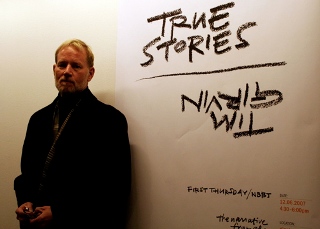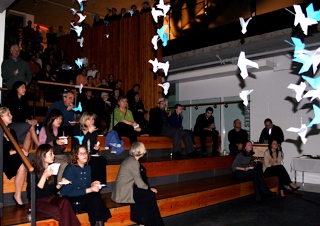The brand story as a communications tool, in brand management and experience design.
What is brand, what is story, what is message, what is experience?
What changes are emerging in the concept of branding, storytelling, community and communications? What direction, if any, relates to the brand in the context of space and design? What about the inter-relationship of architectural and interior design strategy, community relationships (client or audience) and business and corporate branding, services and commodities? What of hospitality and resorts, experience design and brand integrations? Good questions? Worth exploring?
I’d proffer yes.
The nature of the talk at NBBJ is the same form of query and exploration I’d offered at the close of the 90s, in a presentation for the strategic branding speakers summit at Procter & Gamble. But it’s never a stopping point as a point of intensity in direction; it’s not over — and likely never will be. Because, fundamentally, it’s about finding the truth. And the truth in the story, the truth in living, the truth in the propositions of business.
It’s about True Stories.

And the premise, frankly, is profoundly simple.
That basic line of thinking emanates to, from, and around this simplistic question: “what’s your story?”.
I mean, really, what is it? If you’re a business, what’s the premise, what’s the promise? What’s the use? Who cares about it, about you? Does your modeling really work? Do people really get it — is your story understandable? What, to comprehension (with-holding, to the original etymology: think: prehensile).

The Stairs | NBBJ | Seattle headquarters
I mean, really, what’s your story? If you’re a person, what’s the premise of your living; what’s the promise that you offer? What role are you figuring, in the concept of living — what’s the legacy of your life, your story — thus far…? When you think about your story, when you tell it — do people understand it?
It’s really important to get back to human-ness. We’ve forgotten about some of this, the idea of the human being part of the brand. We’ve thought about that engineered idea and ideal of efficient commerce, but we’ve forgotten about the human character of how people connect, exchange, link up. FaceBook. MySpace. The sharing of YouTube, the selfmade worlds of Second Life, all speak to people creating vast interactive networks, which are, inherently, about telling stories. It’s about the personal brand, the person story — and that same construct approaches the brand storytelling of a business enterprise.
But there are layers to the construct of the story, and I’m not going to go deeply into that premise. Not here, at least. To the nature of how you might tell your story — there would be the hope, from my part, to learn about the story of you. Not so much about your work, but more about you. You first, then your work — and how does your work relate to the presence that is you? And I believe, in a way, that the same grouping of premises might be applied to the query of a business — what’s the heart of it, what fires the culture — then what makes it work? And in that work, what story might be there. Herein, the beginnings of the labeling and the layering.
So in a way, in referencing the structuring of a brand like NIKE — the center point of the cultural / cult genetics there are Bill Bowerman — and his legacy. Bill is at the heart of the brand; he’s at the center of the mantra; he’s sitting on the shoulder of every employee, every designer. He’s the progenitor of the code — the brandcode® — that rules the dynamics of the brand and its forward movements. That genetic structure, the personality of the personable (please forgive me for that…) extends outwardly to multiple composites and expressions of that character. That is the leadership, the product development, the visualizations, the principles of retail design, brand strategy and the outcomes for growth, the alliances and endorsements all align with the code. And the story is, at once, the spiritual character of Bill Bowerman, but then the story layers out and connects to virtually all attributes of the brand.
Do that for Apple. Steve Jobs. What’s the story, what’s the layering? How far, how detailed, how robust, the layering of the story and the reaching out to the markets and audiences that embrace the brand?
The real point is just that. What’s the point, what’s the story? Who cares about it. And the point is, that people that love that brand love that story.
When I presented to the team at nbbj — what questions emerged? The questions were intriguing, as you might expect from an organization that prides itself on insightful intelligence in creative explorations and constant critical analyses and inquiry. What is the relevance of the story if that story might not be a good one? Or a pretty one. You can imagine it — what company, what brand, might have a story, but it’s not about the constructive and human nurturing (for example) but more about rapacity, stamping out, hammering…down prices, let’s say. What, story, then…?
My comment in response to that is the same. What’s the story that’s at the heart — and if there’s truth, then tell it. So, if that brand might be about abusing resources to get the “best damned price”. Then that’s the story, and there’s the heart of the relationship. And in a completely commodity based relationships structuring, that makes sense. Cents, actually. But that can be a driver. And someone’s good stories can be there.
I believe, as well, that aside from the nature of the connection to the story, that there’s a narrative there; it’s a matter of how the relationship holds that story. The modeling of the story will be about how that story is re-aligned to the person. So when I relate to NIKE, I relate as an athlete, re-imagined. And I didn’t start that way, I shifted my story to aspire to that premise. And that promise to my self. And the story of NIKE became my story.
But it’s not about the story alone — the brand story is the heart of the proposition, it’s the genetic structuring that fuels the organic and osmotic character of the transparency of the brand, but there are other layers, ways in which that flows out dimensionally to levels of experience. And how you, or I, might connect to the story. And the personal holding of that story. The comprehension of it.
• Story is ancient.
• Story is mythic, even archetypal in character.
• Story is self engendering — it’s a seed that expands; it’s a genetic component of the heart of the brand, that can extend and expand into virtually every detail of the brand experience.
• Stories are human sharing — human embracing.
• Stories are yours, stories are mine, stories are brands (to the etymology there, fire — an apt metaphor for the campfire allegory).
• Stories are viral — they entice and compel community, for they reach out to be shared — blogged, explored in digital villages, defined in the second life of imagined worlds, emailed, videographed.
• Stories that are representative should be true.
I’ll tell you my story — then will you tell me yours?
Tim Girvin | South Lake Union | NBBJ Seattle